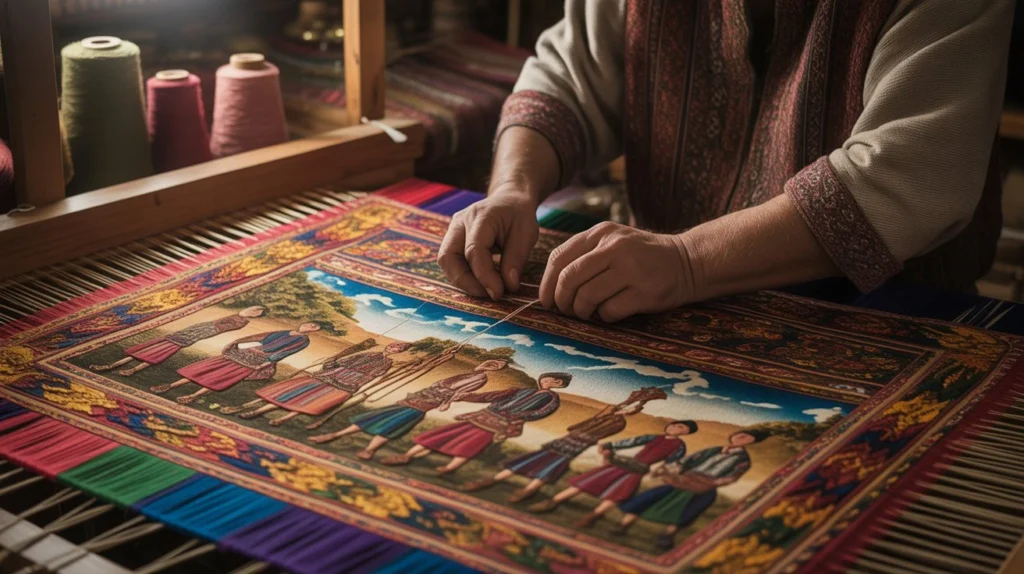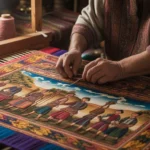The Anatolian cultural treasure known as çievri offers a rich tapestry of history, symbolism, and regional identity. Rooted in centuries of craft, this textile art is more than decoration—it embodies storytelling, emotion, and heritage. I write this from my own exploration of Turkish rural craft, eager to show how genuine tradition still thrives in hidden villages and artisan studios.
Understanding çievri in Historical Context
In Anatolia, a woman’s çievri served both function and meaning. It was part of her dowry, a daily cover, and a discreet message board. Over the Ottoman era, this cloth evolved into a symbol of personal identity. What began as simple scarves became canvases of emotion and artistry. The craft passed down generations, with artisans investing personal meaning into each stitch. When walking through a rural market, I saw pieces that a grandmother proudly labeled as seventy years old—each wear line and faded hue narrating its journey.
Why çievri Matters Today
With mass production replacing so many handmade crafts, çievri stands out as resilient. Women in remote towns still practice the technique using traditional looms and natural dyes. The resurgence of global interest in sustainable textile and cultural fashion means these patterns are being adapted by designers—while ensuring the technique remains authentic. That evolution matters now because the world is losing subtle cultural codes encoded into thread. Reviving çievri helps preserve memory itself.
Emotional Symbolism and Cultural Value
Every piece is coded. Floral motifs signal life stages or watery longing; geometric forms convey protection or balance. In some villages, the edging—called oya—carried more meaning than the body of the cloth. A certain flower stitch could say “I love you,” while another might say “I don’t.” These messages were clear without one spoken word. I experienced this when chatting with an elderly weaver whose patterns subtly recorded seasons, celebrations, and grief as carefully as entries in a diary.
Challenges Faced by Artisans
Today, many patterns and techniques are at risk. Younger women migrate to cities, and mass-produced imitations replace genuine pieces. Real handmade examples show slight inconsistencies—imperfections that reveal human touch. Machines create perfect replicas, but lose nuance. Without workshops, mentors, and market access, many artisans may stop practicing. I’ve watched cooperative groups offering lessons to preserve dying knowledge, but the risk remains real.
Real‑World Revival and Applications
I once assisted a creative project pairing rural weavers and Istanbul-based designers. The result: digitally adapted motifs turned into scarves, dresses, and home decor. Worn by modern audiences, the designs spark conversation: they’re aesthetic yet deeply rooted in story. Cultural exhibitions have placed ancient pieces beside modern prints, inviting dialogue across time. School programs also let children weave small versions, teaching craft and pride simultaneously.
Identifying and Caring for Authentic Work
Genuine handmade textiles show irregularities in stitch and slight dye variation. They carry warmth—even faint scent of cedar or rosewater from storage in hope chests. Buying directly from village cooperatives or certified craft sales helps avoid mass‑market imitations. Store them flat with acid‑free paper, avoid moisture, and wash gently with pH‑neutral soap.
Actionable Steps for Anyone Interested
Entering the world of this textile tradition is accessible. Begin by connecting with cultural cooperatives or online craft groups. Attend a weaving workshop in Anatolia or order from trusted artisan platforms. If you want to start your own piece, begin with simple needle–lace edging on cotton fabric, letting motifs emerge from local lore or personal story. Document what motifs mean to you, so your cloth becomes narrative as well as needlework.
When Tradition Meets Modernity
Rather than nostalgia, today’s adaptation represents continuity. Courtyard terraces in Izmir host weaving days open to visitors. Young designers offer clothing imprinted with traditional patterns. Exhibitions pair ancient scarves next to modern fashion. In digital media, influencers show how these motifs connect roots and creativity—reaching global audiences, while reinforcing rural pride.
Summary Reflection
Cada piece of handmade cloth carries more than fabric. It carries culture, emotional codes, history, and craftsmanship. The tradition persists not despite modern changes but through them. Handmade pieces, modern adaptations, and cultural efforts together offer hope for survival. As someone who witnessed elder artisans, mentored younger learners, and joined cultural preservation circles, I believe in the power of cloth to preserve voice.
FAQ
What is a çievri in Turkish tradition?
It is a handcrafted headscarf or kerchief that conveys emotion, identity, and symbols through stitching and motifs.
How can one tell a handmade piece from a machine-made replica?
True handmade works show slight imperfections, color variation, and warmth in texture—machine copies are too uniform.
Where can I find authentic pieces?
Purchase from certified artisan networks, village cooperatives, museums, and cultural heritage fairs.
Are patterns still meaningful today?
Yes. Many artisans and designers retain traditional motifs and their symbolic intent in modern applications.
Can beginners make a piece themselves?
Absolutely. Simple needle‑lace edging and small design motifs are accessible with starter workshops or kits.
Why preserve this craft now?
Because without preservation, these emotional, coded textiles risk disappearing into homogenized mass production.
Conclusion & Next Steps
Çievri remains a quiet wonder at the crossroads of craft and culture. Each scarf, each stitch, is a conversation with history. To preserve and celebrate this tradition, I invite you to explore living craft communities, seek genuine pieces, or craft your own story-threaded cloth. Let heritage live in every weave.






